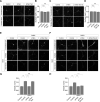The post-synaptic scaffolding protein tamalin regulates ligand-mediated trafficking of metabotropic glutamate receptors
- PMID: 32376687
- PMCID: PMC7307197
- DOI: 10.1074/jbc.RA119.011979
The post-synaptic scaffolding protein tamalin regulates ligand-mediated trafficking of metabotropic glutamate receptors
Abstract
Group I metabotropic glutamate receptors (mGluRs) play important roles in various neuronal functions and have also been implicated in multiple neuropsychiatric disorders like fragile X syndrome, autism, and others. mGluR trafficking not only plays important roles in controlling the spatiotemporal localization of these receptors in the cell but also regulates the activity of these receptors. Despite this obvious significance, the cellular machineries that control the trafficking of group I metabotropic glutamate receptors in the central nervous system have not been studied in detail. The post-synaptic scaffolding protein tamalin has been shown to interact with group I mGluRs and also with many other proteins involved in protein trafficking in neurons. Using a molecular replacement approach in mouse hippocampal neurons, we show here that tamalin plays a critical role in the ligand-dependent internalization of mGluR1 and mGluR5, members of the group I mGluR family. Specifically, knockdown of endogenous tamalin inhibited the ligand-dependent internalization of these two receptors. Both N-terminal and C-terminal regions of tamalin played critical roles in mGluR1 endocytosis. Furthermore, we found that tamalin regulates mGluR1 internalization by interacting with S-SCAM, a protein that has been implicated in vesicular trafficking. Finally, we demonstrate that tamalin plays a critical role in mGluR-mediated internalization of α-amino-3-hydroxy-5-methyl-4-isoxazolepropionic acid receptors, a process believed to be the cellular correlate for mGluR-dependent synaptic plasticity. Taken together, these findings reveal a mechanistic role of tamalin in the trafficking of group I mGluRs and suggest its physiological implications in the brain.
Keywords: G-protein coupled receptor; S-SCAM; endocytosis; internalization; metabotropic glutamate receptors; neurotransmitter receptors; synaptic plasticity; tamalin; trafficking.
Conflict of interest statement
Conflict of interest—The authors declare that they have no conflicts of interest with the contents of this article.
Figures







Similar articles
-
Regulation of Metabotropic Glutamate Receptor Internalization and Synaptic AMPA Receptor Endocytosis by the Postsynaptic Protein Norbin.J Neurosci. 2022 Feb 2;42(5):731-748. doi: 10.1523/JNEUROSCI.1037-21.2021. Epub 2021 Dec 14. J Neurosci. 2022. PMID: 34907024 Free PMC article.
-
A vital role for PICK1 in the differential regulation of metabotropic glutamate receptor internalization and synaptic AMPA receptor endocytosis.J Biol Chem. 2023 Jun;299(6):104837. doi: 10.1016/j.jbc.2023.104837. Epub 2023 May 18. J Biol Chem. 2023. PMID: 37209824 Free PMC article.
-
A Critical Role for Sorting Nexin 1 in the Trafficking of Metabotropic Glutamate Receptors.J Neurosci. 2018 Oct 3;38(40):8605-8620. doi: 10.1523/JNEUROSCI.0454-18.2018. Epub 2018 Aug 24. J Neurosci. 2018. PMID: 30143569 Free PMC article.
-
Group I Metabotropic Glutamate Receptors (mGluRs): Ins and Outs.Adv Exp Med Biol. 2018;1112:163-175. doi: 10.1007/978-981-13-3065-0_12. Adv Exp Med Biol. 2018. PMID: 30637697 Review.
-
Inside story of Group I Metabotropic Glutamate Receptors (mGluRs).Int J Biochem Cell Biol. 2016 Aug;77(Pt B):205-12. doi: 10.1016/j.biocel.2016.03.003. Epub 2016 Mar 14. Int J Biochem Cell Biol. 2016. PMID: 26987586 Review.
Cited by
-
Postsynaptic Proteins at Excitatory Synapses in the Brain-Relationship with Depressive Disorders.Int J Mol Sci. 2022 Sep 28;23(19):11423. doi: 10.3390/ijms231911423. Int J Mol Sci. 2022. PMID: 36232725 Free PMC article. Review.
-
Tamalin Function Is Required for the Survival of Neurons and Oligodendrocytes in the CNS.Int J Mol Sci. 2022 Nov 2;23(21):13395. doi: 10.3390/ijms232113395. Int J Mol Sci. 2022. PMID: 36362204 Free PMC article.
-
Metabotropic Glutamate Receptor Trafficking and its Role in Drug-Induced Neurobehavioral Plasticity.Brain Plast. 2021 Oct 19;7(2):61-76. doi: 10.3233/BPL-210120. eCollection 2021. Brain Plast. 2021. PMID: 34868874 Free PMC article. Review.
-
Protein Networks Associated with Native Metabotropic Glutamate 1 Receptors (mGlu1) in the Mouse Cerebellum.Cells. 2023 May 5;12(9):1325. doi: 10.3390/cells12091325. Cells. 2023. PMID: 37174725 Free PMC article.
-
Mechanisms of selective G protein-coupled receptor localization and trafficking.Curr Opin Cell Biol. 2021 Aug;71:158-165. doi: 10.1016/j.ceb.2021.03.002. Epub 2021 May 7. Curr Opin Cell Biol. 2021. PMID: 33965654 Free PMC article. Review.
References
Publication types
MeSH terms
Substances
LinkOut - more resources
Full Text Sources
Molecular Biology Databases

